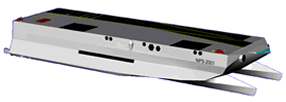|
Executive Summary
 Currently, no system exists that provides a sea-based distributed aviation platform capability. The emergence of Unmanned Air Vehicles (UAVs) / Unmanned Combat Air Vehicles (UCAVs), the continued U.S. Navy focus on the littorals, the desire for force distribution, the need for operational cost reductions, and the advent of Network Centric Warfare (NCW) all combine to support the requirement to re-evaluate how littoral operations will be conducted in the future. Given this background, a bottom-up design of a ship supporting a primarily UAV / UCAV air wing in a low to medium threat environment, is of significant interest. SEA ARCHER meets this interest. Currently, no system exists that provides a sea-based distributed aviation platform capability. The emergence of Unmanned Air Vehicles (UAVs) / Unmanned Combat Air Vehicles (UCAVs), the continued U.S. Navy focus on the littorals, the desire for force distribution, the need for operational cost reductions, and the advent of Network Centric Warfare (NCW) all combine to support the requirement to re-evaluate how littoral operations will be conducted in the future. Given this background, a bottom-up design of a ship supporting a primarily UAV / UCAV air wing in a low to medium threat environment, is of significant interest. SEA ARCHER meets this interest.
Reductions in manning were achieved through a high degree of automation, including the damage control architecture. In further support of reduced manning, a maintenance concept that calls for much of SEA ARCHER’s maintenance to be performed by outside activities is utilized. A hybrid air-cushion-catamaran hull form and waterjet propulsion were employed to achieve the high speed transit goal.
SEA ARCHER was designed as part of a wider interdisciplinary project, with teams from the Systems Engineering and Integration Program, the Department of Aeronautics and Astronautics, and the Total Ship Systems Engineering program. Students from the Logistics Management and Aviation Maintenance Curricula also participated.
CROSSBOW - Is the force level structure that includes:
SEA ARCHER - Aviation ship
SEA ARROW - Unmanned Combat Air Vehicle
SEA LANCE - Small Combatant (2000 TSSE design)
SEA QUIVER - Logistics Support Subsystem
More Information
The following documents are available for download.
- Final Report
The final student report (PDF file 6,700 KB).
- Project Presentation:
- Right-click to download Rhino-3D drawings:
- Student Brief (Real Media). Please choose according to your connection speed:
|